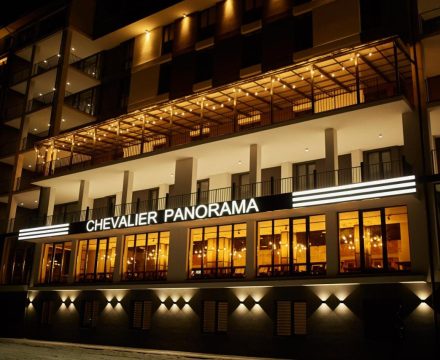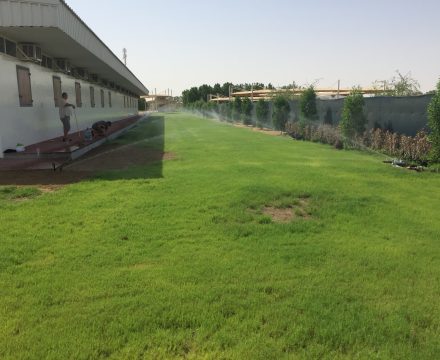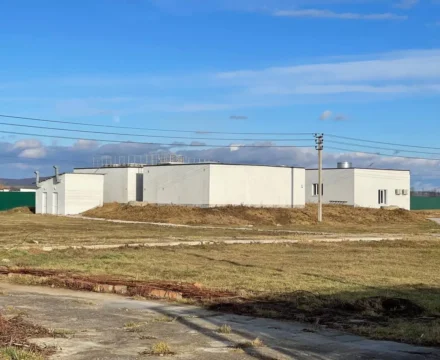Technology Platon
“PLATON” wastewater treatment technology
The staff of the company “Aquacenter” developed a technology for wastewater treatment, on the basis of which a line of small treatment facilities of the “PLATON” type was created with a capacity of 15 to 400 m3 / day. The technology provides for complete biological wastewater treatment with the removal of nitrogen and phosphorus compounds, as well as deep sludge mineralization. The wastewater treatment process is biological, chemical-free and uses its own natural resources to convert wastewater into a clear, colorless and odorless liquid. All this happens thanks to the bioreactor, where oxygenated microorganisms attach to the flooded process load, forming a biomass ready to quickly and efficiently treat wastewater. The main design features of the PLATON-type MTP have been industrially tested at several biological treatment plants. The operating experience of these stations has shown the prospects of the developed technological methods and the reliability of this wastewater treatment method. Treatment facilities of the Platon type include a biological treatment module made of monolithic reinforced concrete, which is a group of tanks (sections) separated by partitions. Variants of buried and semi-buried location of the biological treatment module are possible.  It is also possible to have an underground location using the OS platform for car parking.
It is also possible to have an underground location using the OS platform for car parking.  In addition to the biological treatment module, the treatment facilities include a technical room (building) in which it is supposed to place blower equipment, shut-off valves, a control panel, dosing pumps for sodium hypochlorite solution. The building is proposed to be placed on a standard road slab. Dimensions of the building in terms of: 2 x 6 m. The height of the building, including the thickness of the slab 0.2 m, is – 2.2 m. There are options for recessed and semi-recessed location of the building.
In addition to the biological treatment module, the treatment facilities include a technical room (building) in which it is supposed to place blower equipment, shut-off valves, a control panel, dosing pumps for sodium hypochlorite solution. The building is proposed to be placed on a standard road slab. Dimensions of the building in terms of: 2 x 6 m. The height of the building, including the thickness of the slab 0.2 m, is – 2.2 m. There are options for recessed and semi-recessed location of the building.
Bioreactor.
The main element of the biological treatment module is a 4-stage bioreactor. Its design consists of four sequentially placed sections operating in the circulation-displacement mode. Sections of the bioreactor have an elongated rectangular shape. The bottom of each section has slopes that form a longitudinal groove along the entire length of the section (see drawing 1.). Each section has a combined aeration system consisting of fine-bubble disc aerators that provide efficient diffusion of oxygen and flooded airlifts that provide sediment lifting from the chute and mixing of the sludge mixture in the section body. Also, each section has a system of airlifts for pumping excess sludge from the collection chute.  In addition to the combined aeration system, each section of the bioreactor is equipped with a block-type polymer feed having a high specific surface area.
In addition to the combined aeration system, each section of the bioreactor is equipped with a block-type polymer feed having a high specific surface area. 
Polymer loading.
The novelty of the technology used in PLATON-type treatment facilities lies in the absence of a primary and secondary settling tank and the use of a polymeric load throughout the bioreactor, while in most MWWTPs, a polymeric load is used only at the last stages of treatment or is not used at all. The polymer loading has a high specific surface area, on which the biomass is placed. In this case, unlike free-floating activated sludge, water purification from organic substances will be carried out under the influence of various microorganisms attached to the load in the form of a biofilm. Attached microorganisms (it is more correct to say hydrobionts, since in this case, in addition to microorganisms, higher organisms will take part in the purification: protozoa, molluscs, worms, etc.) replace one another in the space of the bioreactor, creating a spatial succession of microorganisms and a natural trophic chain of hydrobionts. Purification of water from the cells of microorganisms that previously purified water from organic pollution, under these conditions, occurs due to eating them by first-order predators, first-order predators by second-order predators, etc. Whereas in the classical system aerotank – secondary sedimentation tank there is a monoculture of activated sludge (the species composition of microorganisms in the entire volume of the bioreactor is the same). The PLATON technology provides for the design of a bioreactor as a multi-stage system, where each section has its own parameters and operates on an adapted microflora. At each stage of purification, a certain biocenosis operates, which is able to function most effectively under these conditions. The polymer loading keeps the biocenosis in place, thanks to it it is possible to produce adhesion of organic contaminants and immobilize hydrobionts on its surface. At the initial stage of the purification process, when a large part of the substrate per unit of biomass, the trophic chain of hydrobionts begins with protozoa and heterotrophic bacteria that easily adapt to difficult and difficult conditions of high concentrations of organic substances and xenobiotics (surfactants, oil products, fats, etc.). ). Further, with a decrease in water pollution, the number of bacteria decreases, more free-swimming protozoa that feed on bacteria appear: rotifers and crustaceans, and in the end – such intense filter feeders as molluscs, predatory protozoa and lower invertebrates. Almost all of these organisms are mobile, and some of them are very mobile. However, polymer loading offers them a place to live, breed and feed. The biocenoses of free-floating sludge and the biofilm formed on the surface of the load are identical when treating the same water, but the number of species of organisms is different. An indicator of the good condition of the biofilm is the presence of round ciliates, ciliary, flagella, Nematoda worms, rotifers. Particles of fat, protein substances, etc. stick to the surface of the polymeric load. elements. Air bubbles are also attached to them, and this ensures the supply of oxygen and food to microorganisms even during breaks in the operation of the blowers. Thus, the process of active consumption of organic substances does not stop, while the operating time of the blower is reduced. As a result, energy consumption is reduced and the service life of the blowers is increased.
The use of polymeric loading corresponds to modern achievements in the field of biological wastewater treatment and has the following advantages over the traditional one:
- Ability to work in conditions of significant fluctuations in pollution concentrations (from high to very low);
- Adaptation to volley discharges of wastewater (both in terms of consumption and concentrations of pollution), since the hydrobionts attached to the load are difficult to wash out with the flow of treated water, and the multilayer nature of the hydrobionts immobilized on its surface protects them from destruction by toxic substances (xenobiotics);
- The purification process takes place with less excess biomass. At the same time, its ash content almost doubles, as a result of which the process of silting is faster and more efficient. The degree of sludge mineralization and its moisture-releasing characteristics are higher. The amount of excess sludge is many times less.
- The interaction of groups of hydrobionts with each other, both due to their direct-flow movement along with the flow of purified water, and due to regular counter-current sludge exchange between the stages, increases the stability of the system as a whole and increases the cleaning effect.
- This technology can operate without constant sludge recirculation and a secondary settling tank, which significantly saves capital investments and energy costs, and simplifies the effluent flow pattern.
- Possibility of carrying out a periodic mode of aeration. Since the bulk of hydrobionts is placed on the surface of the load, it does not settle to the bottom and does not rot.

Basic design principles for MOCs of the PLATON type.
MOS type PLATON are designed according to the following principles:
- Work in the extended aeration mode.
- Delay and crushing of solid waste coming with sewage. Existence of system of self-cleaning of a grid.
- Ensuring the reception of volley discharge of wastewater without removal of sludge from the installation with treated wastewater.
- The biological treatment system is multi-stage, with multi-circuit return recirculation of activated sludge, proportional to the amount of incoming wastewater. The technology is based on a two-wire system.
- Ensuring the biological removal of nitrogen, creating conditions for the passage of a two-stage process of nitrification-denitrification.
- Automatic removal of excess activated sludge (biofilm) and maintenance of its required thickness (concentration).
- Automatic switching to economical operating modes when the amount of wastewater entering the treatment is changed in order to save electricity, the service life of electrical equipment and equalize the biological process in the event of a long-term absence of wastewater.
- Switching to afterburner modes when sewage enters in an amount exceeding the calculated one.
Advantages of PLATON technology.
Basic :
1. Extremely low volume of excess sludge and solid waste. Due to the rejection of the primary clarifier and the use of the method of complete biological treatment in a large volume of the bioreactor, a high degree of sludge mineralization is achieved (the proportion of organic substances contained in the microbial mass of excess sludge is reduced to extremely small values). As a result, after cleaning 1 m3 of wastewater, no more than 0.5 liters of excess sludge is formed. The use of the proposed technology makes it possible to pump out / unload excess sludge no more than once a month, which in turn makes it possible to completely abandon sludge sites and sludge dehydration systems. 2. Energy efficiency; The use of a polymer load and sludge collection chutes in the design of the bioreactor optimized the process of mass transfer and mixing of the sludge mixture and made it possible to implement a periodic aeration mode, as well as to place the aeration system (silt lifting/suspension airlifts and fine-bubble disc aerators) above the bottom of the bioreactor by 0.6 – 0 .8 m. This, in turn, made it possible to use low-pressure blowers of a single-channel design, which are distinguished by high reliability and energy efficiency. Thanks to the use of blowers of this type, the specific energy consumption during wastewater treatment does not exceed 0.33 – 0.6 kW / m3 of treated wastewater, which makes the proposed treatment facilities worthy competitors to “highly intelligent” systems with a small volume of bioreactors. This organization of the process allows activated sludge to be constantly in operation. Dead sludge, being heavier, gradually accumulates in the lower part of the tank. Since a sufficient amount of oxygen is constantly present in the water, rotting does not occur. In this zone, other forms of microorganisms that eat silt appear. The dimensions of the container allow this. Thus, in the sludge accumulation gutters, wastewater treatment and a decrease in the volume of dead sludge continue. 3. Stability of the biological treatment process. Thanks to the new technology of using attached biocenosis in the mode of extended aeration, a consistently high quality of wastewater treatment is achieved, regardless of possible burst discharges, both in terms of costs and pollution concentrations. There is a high degree of system inertia. At low values of effluent inflow (substrate deficiency), the operation of treatment facilities also remains stable – degradation and degeneration of the biocenosis does not occur.
In addition to the main advantages, PLATON technology has the following equally important characteristics:
- Possibility of carrying out a periodic mode of aeration. Since the bulk of hydrobionts is located on the surface of the load, does not settle to the bottom and does not rot, aeration is carried out in a periodic mode with relatively long downtime periods.
- Delay and crushing of coarse sewage coming with sewage. Existence of system of self-cleaning of a grid. Small amount of solid waste. Emptying 1 time in 7 days instead of 1 time in 2 days.
- Automatic removal of excess activated sludge (biofilm) and maintenance of its required thickness (concentration).
- Possibility of switching to economical operating modes with a decrease in the amount of wastewater entering the treatment in order to save electricity and the service life of electrical equipment.
- The possibility of a quick transition to the conservation mode with the preservation of the performance characteristics of the biocenosis in the long absence of sewage.
- Quick exit from conservation to operating mode without the introduction of activated sludge.
- The possibility of switching to afterburner modes when sewage enters in an amount exceeding the calculated one. At the same time, productivity increases by 25 and 50%.
- High reliability and durability of a monolithic reinforced concrete module due to the use of modern waterproofing and anti-corrosion additives in concrete at the construction stage.
- Energy efficiency. It is achieved through the use of a periodic aeration regime and the placement of fine-bubble aerators at a height of 1 m from the bottom. Specific electricity consumption is 0.33 – 0.6 kW/m3. In forced modes – 0.45 – 0.7 and 0.75 – 1.2 kW / m3.
- The complete absence of unpleasant odors already at the first stage of cleaning.
- Ease of maintenance and reliability due to the rejection of complex automation and all kinds of sensors. The absence of a complex electronic controller in the control panel makes it possible not to place high demands on the operating personnel. The operation algorithm of the treatment facilities is based on the correlation of the aeration regime with the water disposal regime of the facility.
- The ability to work without email. energy up to 8 hours without the appearance of an unpleasant odor.
If it is necessary to implement remote monitoring of the cleaning process, the facility is dispatched by installing an additional set of equipment without the right to access control of the main equipment.

 Lake water purification. Sports hotel “Chevalier Panorama”, BukovelGo to
Lake water purification. Sports hotel “Chevalier Panorama”, BukovelGo to Filtration of water from the river. “GasthauS” Hotel, BukovelGo to
Filtration of water from the river. “GasthauS” Hotel, BukovelGo to Water desalination. United Arab Emirates, DubaiGo to
Water desalination. United Arab Emirates, DubaiGo to Hotel wastewater treatment. Hotel “Carparosa Hotel & Restaurant”, BukovelGo to
Hotel wastewater treatment. Hotel “Carparosa Hotel & Restaurant”, BukovelGo to Filter station. Enterprise “UPG-Invest” TM “Syaivir” v. MamaevtsyGo to
Filter station. Enterprise “UPG-Invest” TM “Syaivir” v. MamaevtsyGo to





